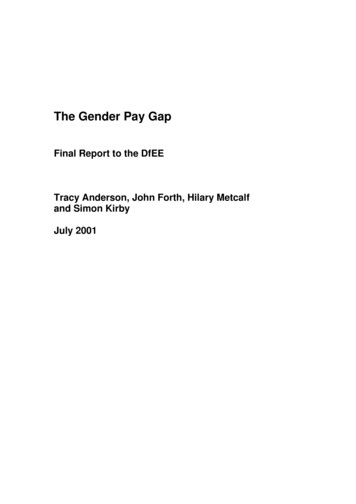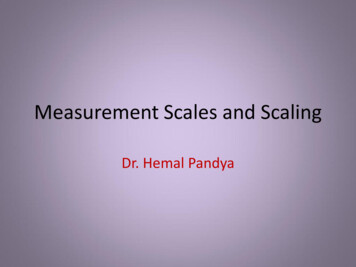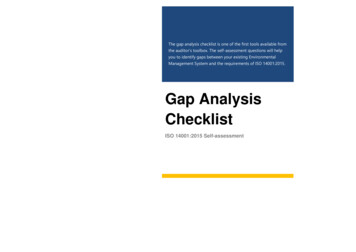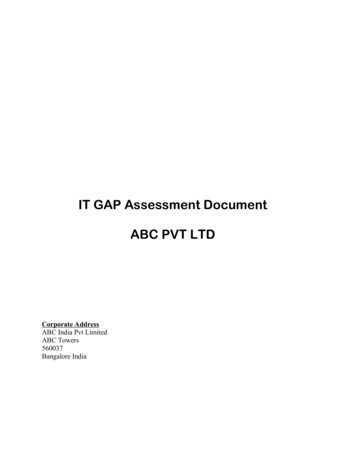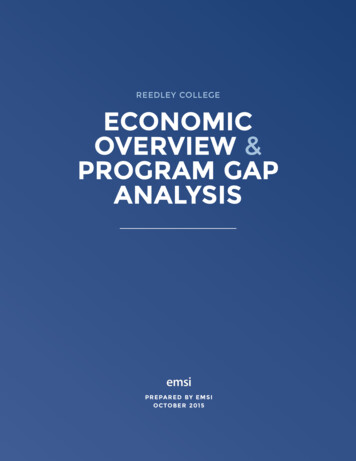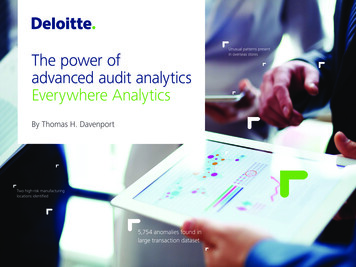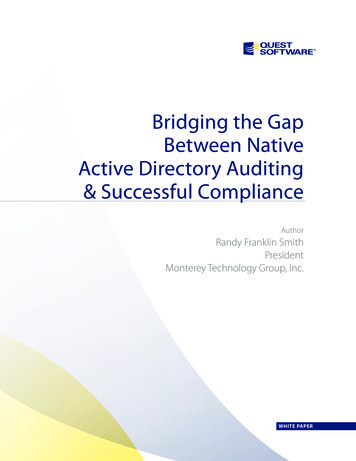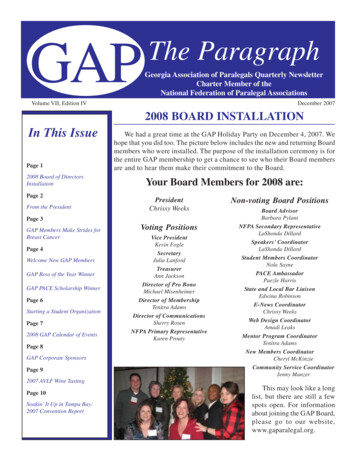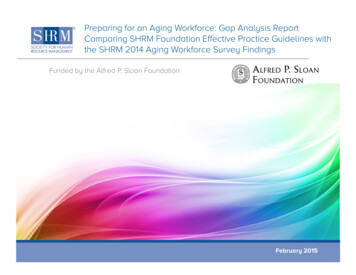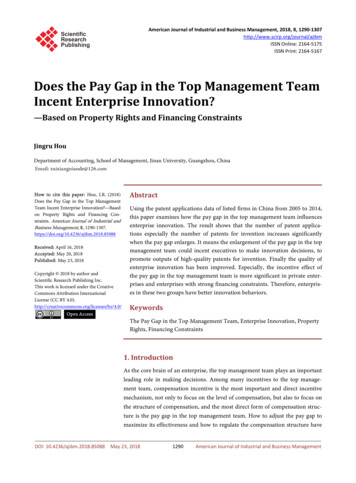
Transcription
American Journal of Industrial and Business Management, 2018, 8, 1290-1307http://www.scirp.org/journal/ajibmISSN Online: 2164-5175ISSN Print: 2164-5167Does the Pay Gap in the Top Management TeamIncent Enterprise Innovation?—Based on Property Rights and Financing ConstraintsJingru HouDepartment of Accounting, School of Management, Jinan University, Guangzhou, ChinaHow to cite this paper: Hou, J.R. (2018)Does the Pay Gap in the Top ManagementTeam Incent Enterprise Innovation?—Basedon Property Rights and Financing Constraints. American Journal of Industrial andBusiness Management, 8, Received: April 16, 2018Accepted: May 20, 2018Published: May 23, 2018Copyright 2018 by author andScientific Research Publishing Inc.This work is licensed under the CreativeCommons Attribution InternationalLicense (CC BY en AccessAbstractUsing the patent applications data of listed firms in China from 2005 to 2014,this paper examines how the pay gap in the top management team influencesenterprise innovation. The result shows that the number of patent applications especially the number of patents for invention increases significantlywhen the pay gap enlarges. It means the enlargement of the pay gap in the topmanagement team could incent executives to make innovation decisions, topromote outputs of high-quality patents for invention. Finally the quality ofenterprise innovation has been improved. Especially, the incentive effect ofthe pay gap in the top management team is more significant in private enterprises and enterprises with strong financing constraints. Therefore, enterprises in these two groups have better innovation behaviors.KeywordsThe Pay Gap in the Top Management Team, Enterprise Innovation, PropertyRights, Financing Constraints1. IntroductionAs the core brain of an enterprise, the top management team plays an importantleading role in making decisions. Among many incentives to the top management team, compensation incentive is the most important and direct incentivemechanism, not only to focus on the level of compensation, but also to focus onthe structure of compensation, and the most direct form of compensation structure is the pay gap in the top management team. How to adjust the pay gap tomaximize its effectiveness and how to regulate the compensation structure haveDOI: 10.4236/ajibm.2018.85088May 23, 20181290American Journal of Industrial and Business Management
J. R. Houalways been constant issues in the field of corporate governance. In response tothe issue of executive compensation, the state has attached great importance andpublished policies to guide it. In August 2014, the adoption and implementationof the compensation system reform plan for the chief executives of enterprisesmanaged by the central government indicated that the reform of executive compensation of state-owned enterprises entered an advanced stage. This reformemphasized the differentiation of executive compensation, and the compensation distribution system should be adapted to the socialist market economy. Atthe same time, the state has brought innovation to the strategy height and encouraged enterprises to carry out technology transformation and promotionconstantly. From “innovation is the key to unlock the growth lock radically”, wecan sufficiently see the significance of innovation in enterprise development andeconomic growth. The top management team is an important decision-makinggroup of an enterprise, and its collaborative cooperation and power of makingdecisions have significant influences on the accumulation of enterprise innovation achievements.Existing researches on the economic consequences of the pay gap in the topmanagement team are mostly from the perspective of corporate performance,investment and executive turnover. However, there is still a lack of deep understanding about how much incentive effect the pay gap can create to enterpriseinnovation. Therefore, based on the continuous improvement of China’s compensation system reform and the background of vigorously advocating innovation, this paper focuses on impacts of the pay gap in the top management teamon enterprise innovation aiming to investigate real effects of the promotion ofinnovation strategy from the persspective of micro-enterprise, so as to providereferences for designing the compensation structure of executives and adjustingincentive methods of innovation.The major contribution of this paper is to explore the role of top managementfor enterprise innovation, extending from the previous focus on CEO personaldevelopment to focus on the whole management team, and analyzing the differences between different property rights and financing constraints. It deepens ourunderstanding of the importance of team incentives to enterprise innovation.The major limitation of this paper is that, due to the limitations of data disclosure, there are no specific types of executives. Different types of executives areplaying different roles in the management of enterprises. For example, the executives in charge of R & D are more important than other executives inhigh-tech enterprises, and the pay gap between them may have different incentive effects on enterprise innovation.The paper is organized as follows. Section 2 shows the literature review anddevelops the hypotheses. Section 3 describes the sample selection and data andprovides the descriptive statistics of all variables. Section 4 shows the empiricalresults about impacts of the pay gap in the top management team on enterpriseinnovation. Section 5 concludes the paper.DOI: 10.4236/ajibm.2018.850881291American Journal of Industrial and Business Management
J. R. Hou2. Literature Review and Hypothesis DevelopmentLiterature ReviewExisting researches on incentive effects of the pay gap in the top managementteam mainly based on tournament theory and social comparison theory, and theresults of those studies were significantly different. The tournament theory suggests that the existence of the pay gap within the top management team makes itpossible for executives to compete with each other as in a tournament. The paygap can effectively incent executives to work hard for higher salaries and promotions, and ultimately improve corporate performance [1] [2] [3] [4]. Analysesbased on social comparison theory suggest that the enlargement of the pay gapadds to the sense of injustice [5] and makes the salary satisfaction [6], productivity and quality of the product decline [7]. Besides, the enlargement of the paygap may lead to a high turnover rate and a lack of team cohesion [8] [9], thenthe employees’ sense of identification is weakened, and it even may cause a conflict between executives. Finally, it has a negative impact on corporate performance [10] [11]. [12] said that in enterprises with high level of teamwork andtechnical complexity, the larger the pay gap was in the top management team,the lower growth the enterprise had.Another set of literature related to this paper is about the factors affecting enterprise innovation. Foreign scholars have explored the factors from differentperspectives: Some researchers found that the increase of shareholding ratio canprovide executives with a stable working environment, make them reduce myopic behaviors and promote the increase of innovation outputs ultimately. Besides, analysts could evaluate a firm based on its performance, making it possiblefor executives to reduce the investment of innovation due to short-term performance pressures. So analysts’ reports may have a negative impact on enterpriseinnovation. Moreover, other researchers said that the increase of stock liquiditycan increase the likelihood of short selling and the risk of hostile takeover, andthis could force executives facing short-term performance pressures to cut downthe activities of innovation. Domestic scholars’ researches on the factors of innovation can be divided into internal and external causes. From the perspectiveof the enterprise, papers such as [13] [14] found that compensation incentive,shareholding and overconfidence of executives can promote innovation activities. Besides, compared with other types of enterprises, private enterprises havemore inputs and better efficiency for innovation. In terms of external environment, [15] this paper agreed with the opinion that the distortion of factor market has inhibited R & D expenditure. And the innovation performance could also be affected by the litigation risks faced by enterprises. Particularly, the litigation of products has a positive incentive to enterprise innovation compared withthe litigation of capital.The financing constraint is another important factor that influences innovation decisions of executives. Financial constraints pose impacts on investmentbehavior, R & D expenditure, and innovation outputs. Innovation activities reDOI: 10.4236/ajibm.2018.850881292American Journal of Industrial and Business Management
J. R. Houquire sufficient cash investment; otherwise, limited internal cash provision aswell as drained external fund-raising will put enterprise into a hard choicewhether to continue to innovation or to drop it in order to control the operationrisk. In addition, State-owned enterprises are different from private ones facinginnovation decisions in terms of the distinguished property institutions.State-owned enterprises, with strong political connections with government andbanking system, can easily get credit resources [16] [17], while private enterprises, discriminated in loan policies, face harder financing constraints.3. Hypothesis DevelopmentSince innovation activities are characterized by long cycles and high risks, a reasonable pay gap in the top management team may incent executives to makerisky innovation decisions in order to promote the development of innovationactivities. In a top management team, the pay gap can make low-paid executiveswork harder for salary increases and promotions. At the same time, it can alsomake high-paid executives feel more worried about their present performance sothat they force themselves to continue working hard. This kind of mechanismcould reduce the monitoring cost of shareholders to management, relieve theprincipal-agent problem, and then improve the corporate performance. Thequantity and quality of innovation outputs also affect the performance of executives, and it will incent executives to make more effective innovation decisions.In recent years, China’s enterprise innovation has gradually transformed fromcaring purely about the quantity to paying more attention to the quality alongwith innovation outputs have had a change from simple designs to high-tech inventions. And the goal of enterprise innovation is changing from catering totaste of government to increasing market value [18]. In these situations, the paygap in the top management team may be an important factor affecting enterpriseinnovation. So we draw to Hypothesis 1.Hypothesis 1: Enterprises innovate more frequently and especially earn morehigh-quality innovation outputs with the enlargement of the pay gap in the topmanagement team.Property rights are important when we analyze the impact of the pay gap inthe top management team on enterprise innovation. Differences in propertyrights make incentives for executives significantly different between state-ownedenterprises and private enterprises. Firstly, the government has strict compensation restrictions on state-owned enterprises. When the government intervenes inaffairs of state-owned enterprises, the implementation of compensation restrictions appears to be the best choice for the government due to the fact of information asymmetry and the government can’t give each enterprise an appropriatecompensation contract which is fully compliant with the characteristics of theenterprise development [19]. Compared with state-owned enterprises, the government does not push compensation restrictions on private enterprises. Executive compensation of private enterprises is determined by the board of directorsDOI: 10.4236/ajibm.2018.850881293American Journal of Industrial and Business Management
J. R. Houaccording to performance of executives, and the compensation varies largelywith the performance. Secondly, the marketization of executives in state-ownedenterprises is at a low level. Most of executives in state-owned enterprises areappointed by the government, so selections or promotions of them are not exactly matched with their performances. While executives of private enterprisesare mostly selected from the manager market through competition. Performance, personalability and value creativity have always been the main focus oftheir selections or promotions [20]. It can be seen that due to the restriction ofcompensation and promotion, the pay gap is not sufficient to incent executivesin state-owned enterprises to carry out innovation decisions with high risks anduncertainties. However, in terms of executive compensation and promotion areboth linked to the performance in private enterprises, the existence of the paygap makes executives have more incentives to work hard, make innovation decisions actively, and enhance their own value by relying on innovation outputs. Sowe draw to Hypothesis 2.Hypothesis 2: Compared with state-owned enterprises, private enterprises innovate more frequently and especially earn more high-quality innovation outputs with the enlargement of the pay gap in the top management team.Besides institutional differences, financing constraints that most enterprisesface in their developments are important factors that hamper the incentive policies. Performances of enterprises with weak financing constraints are relativelyhigh in average, which discourages executives to involve innovation activitiesthat may be bad for their performances, even though there is a certain pay gap inthe top management team. On the other hand, enterprises with limited financialresources ,which have been in a lower position in credit and capital market, consider innovation an opportunity to deliver positive signals to banks and governments, show their potential of development, and thus increase their marketstandings and to earn resources. As the old saying goes, “Poverty gives rise to thedesire for change”, enterprises facing strong financing constraints step morefirmly to innovations. Therefore, with the incentive of the pay gap in the topmanagement team, executives of enterprises with strong financing constraintstend to prove their abilities through high-quality innovation outputs. So wedraw to Hypothesis 3.Hypothesis 3: Compared with enterprises with weak financing constraints,enterprises with strong financing constraints innovate more frequently and especially earn more high-quality innovation outputs with the enlargement of thepay gap in the top management team.4. Research Design4.1. Research SampleIn 2005, the disclosure guidelines for enterprise financial reporting requiredlisted firms to disclose executive compensation forcibly, which provided an important opportunity for calculating the pay gap in the top management team inDOI: 10.4236/ajibm.2018.850881294American Journal of Industrial and Business Management
J. R. Houthis paper. The sample interval of this paper has been cut to 2014 due to the lackof compensation data of executives in recent years. Therefore, we choose the data of Shanghai and Shenzhen a-share listed firms from 2005 to 2014 as a researchsample. According to the actual control of an enterprise, we judge whether itbelongs to a state-owned enterprise or a private one, eliminate the data of financial industries, eliminate the data of ST categories, eliminate the data that majorvariables are missing, and eliminate the data that the asset liability ratio is greater than 1 and the pay gap in the top management team is less than 0. Finally,6157 observations are obtained in this research sample. The data of executivecompensation, patents and other financial indicators are from the CSMAR database, and the data of property rights comes from the CCER database. Considering the effect of extreme values on statistical results, continuous variables aretreated with a tails adjustment on the values of the first and the 99 percentiles ofthe distribution processed by Winsorize. We use the Stata12 for data processingin this paper.4.2. Variable Descriptions1) Enterprise innovationAccording to previous research, enterprise innovation is mainly measured bythe growth rate of new product sales revenue, R & D expenditure divided by total assets and the number of patent applications [21] [22]. Since technologicalinnovation is finally implemented in the efficiency of resource allocation, we select the number of patent applications to measure enterprise innovation.We divide patent applications into high quality patents and low quality patents. High quality patent applications refer to the patents that can promote thedevelopment and progress of technology innovation, while low quality patentapplications generally refer to the patents with lower content of technology.Based on the provisions of China’s patent law as well as existing literature, patents for invention are recognized as high quality patents, and non-inventionpatents, such as utility model and appearance design, are recognized as lowquality patents. We use the number of patent applications, and then standardizeit with plus one and evaluating the natural logarithm of it. The same standardization applies to the number of patents for invention and non-invention patents.2) The pay gap in the top management teamReference to [23], the pay gap in the top management team is equal to the difference between the average compensation of top three executives and the average compensation of other executives, and then we take the natural logarithm ofthe difference. The specific calculation formula is as follows:Teamgap Ln(the average compensation of top three executives the averagecompensation of other executives).3) Property rightsAccording to the character of final control of an enterprise, if it is controlledby the state-owned shareholder, the property right will be equal to 1, otherwiseDOI: 10.4236/ajibm.2018.850881295American Journal of Industrial and Business Management
J. R. Houto 0.4) Financing constraintsReference to [24], we construct KZ index based on the sample of Chineselisted firms to measure financing constraints faced by different enterprises. Thespecific calculation process of KZ index is as follows: 1) For each year of the fullsample, we divide the sample by operating net cash flow divided by total assetsin the last year (CFi, t/ASSETi, t 1), cash dividends divided by total assets in thelast year (DIVi, t/ASSETi, t 1), cash holdings divided by total assets in the last year(CASHi, t/ASSETi, t 1), LEV and Tobin’s Q. If CFi, t/ASSETi, t 1 is lower than itsmedian, we will assign the kz1 to1, otherwise to 0; if DIVi, t/ASSETi, t 1 is lowerthan its median, we will assign the kz2 to 1, otherwise to 0; if CASHi, t/ASSETi, t 1is lower than its median, we will assign the kz3 to 1,otherwise to 0; if LEV islower than its median, we will assign the kz4 to 1, otherwise to 0; if Tobin’s Q islower than its median, we will assign the kz5 to 1,otherwise to 0. 2) Calculate KZindex, and let KZ kz1 kz2 kz3 kz4 kz4 kz5. 3) Use Ordered LogisticRegression with KZ index as the dependent variable to regress to CFi, t/ASSETi, t 1,DIVi, t/ASSETi, t 1, CASHi, t/ASSETi, t 1, LEV and Tobin’s Q, and estimate thecoefficient of each variable. 4) With the estimated results of the regression above,KZ index measuring the financing constraint for each enterprise could be predicted. The greater KZ index is, the stronger the financing constraint of an enterprise is.5) Other control variablesAccording to some researchers such as Junqing Lin (2003), ZhengtangZhang (2007),
The Pay Gap in the Top Management Team, Enterprise Innovation, Property Rights, Financing Constraints 1. Introduction As the core brain ofan enterprise, the top management team plays naimportant leading role inmaking decisions . Among many incentives to the top manage-ment team compensation
